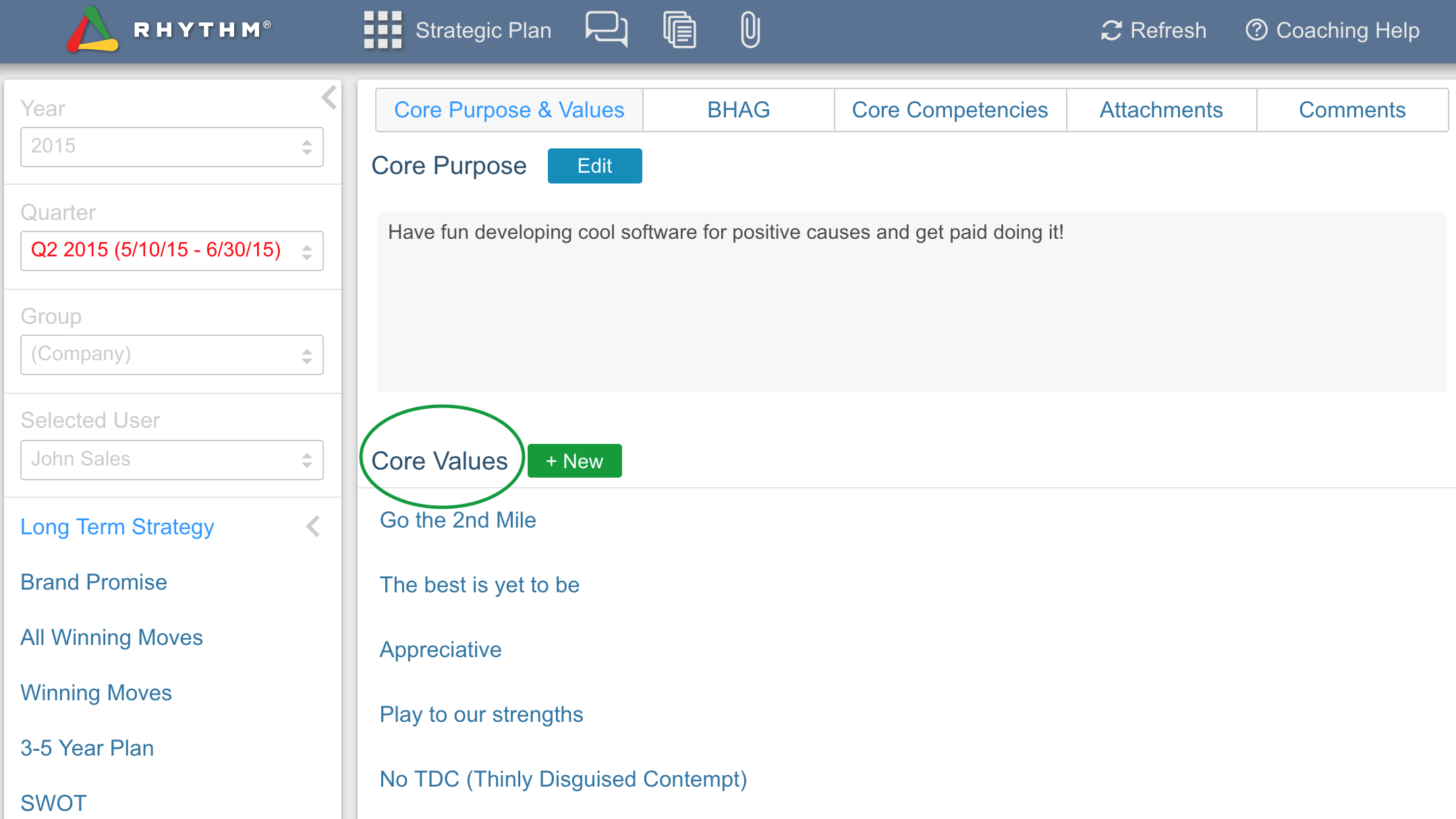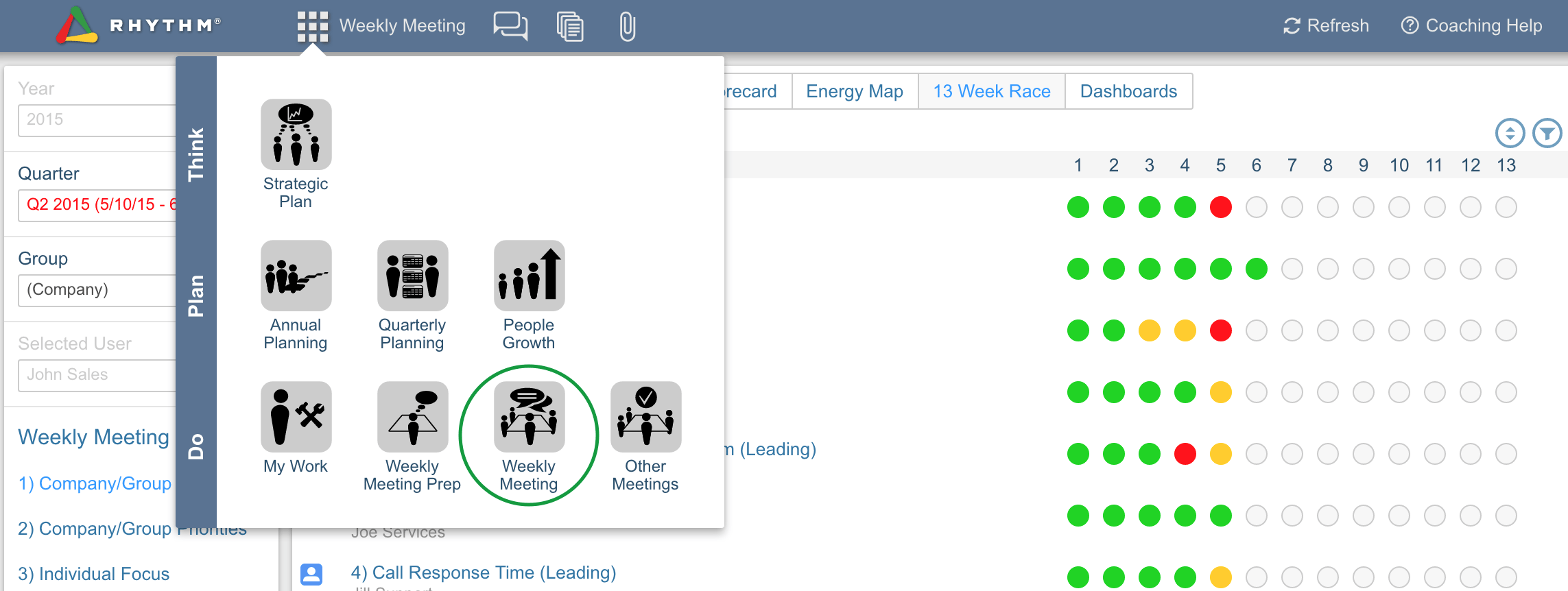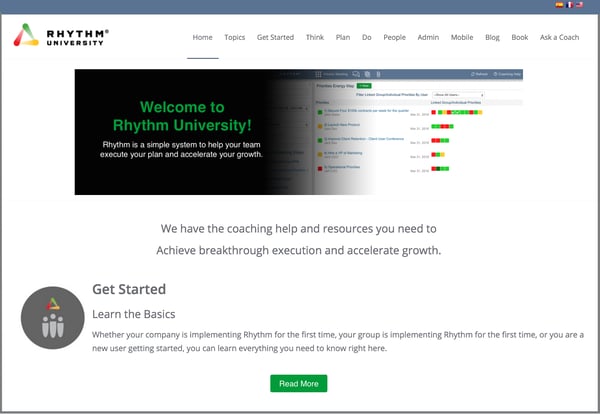Rhythm Rockefeller Habits software helps your company while scaling up.
In 1999, Verne Harnish published his first book, Mastering the Rockefeller Habits: What You Must Do to Increase the Value of Your Growing Firm, outlining three fundamental habits that are key to the successful management of a business. These three fundamental habits - Priorities, Data and Rhythm - could be seen over one hundred years ago in John D. Rockefeller’s unprecedented success as the founder of Standard Oil, and they can still be observed in successful companies today. Since the first publication of the book, thousands of entrepreneurs have adopted the Rockefeller habits and the One-Page Strategic Plan (OPSP) as the foundation for how they scale up their businesses.
In 2006, Patrick Thean developed a method for implementing the Rockefeller Habits called Rhythm. Incorporating the fundamentals of the Rockefeller Habits, the One-Page Strategic Plan and other best practices into one practical system, Rhythm consists of Think, Plan, Do methodology, good habits and disciplines, education and coaching, and a patented software platform that serves as your vehicle for implementing and managing all of these good business practices.
While the Rockefeller Habits are a healthy foundation for your company, they can be applied in any company, any size, in any industry, Rhythm is designed specifically for companies that have grown to a certain size and developed a certain level of complexity. Only 3% of all companies ever reach the $10 million revenue mark, the Elite 3%. These companies have more employees, multiple levels of management, structured departments, multiple product/service offerings, and are faced with a unique set of challenges. Over the past 13 years, we have had the opportunity to work with hundreds of companies around the world who are now part of the Elite 2%. Our observations and research, via consulting sessions, planning sessions, and the review of over 1,000,000 company, departmental and individual priorities have provided unique insights into what specific habits, patterns, and actions helped these companies execute better and grow faster. It is all about execution, read 10 Tips to Scaling Up with Rockefeller Habits.
Below, using Verne Harnish's 6 Page Summary of Mastering the Rockefeller Habits PDF as the framework, we will discuss each key topic and how Rhythm can help you implement that concept in your company. See how you can power the Rockefeller Habits to "scale up" your company with our Rhythm Software Demo.
Rockefeller Habit #1: Priorities
Rhythm allows you to document, collaborate and work in a live environment, has a workspace for every topic on the OPSP and even makes it possible to see how each of the elements is linked to the others. From long-term internal strategy items like Core Values, Core Purpose and BHAG, to external, market-focused items like Sandbox, Brand Promise and Core Customer, and all the way from your 3-5 Year Plan, to your Annual Plan, to your Quarterly Plans and even Individual Quarterly Rocks, you can make comments, add attachments, enter and update planning notes, and create action items. Find the Rockefeller Habits definition here.
The Rockefeller Habits help you scale up your business by getting you into the right Rhythm of Work with the correct meeting habits. Once this communication rhythm is established in your company, you and your team to identify obstacles and opportunities more quickly. This will allow you to create the right quarterly priorities to achieve your growth priorities.
Here are a few of the major topics introduced to us in Mastering the Rockefeller Habits that you will find in Rhythm:
Core Values

Core Values are the handful of rules that will remain constant over time that you believe are key to the long-term success of your business. They already exist and are evident in the behavior of individuals that represent the very heart of the organization. Discovering, understanding and encouraging these core values will strengthen your company’s culture and will provide a good basis for every individual in the company to make decisions on a daily basis. Core Values and purpose are what drives your company and keeps employees engaged.
Core Purpose

Understanding and reinforcing your Core Purpose will provide inspiration for people on a daily basis. People need to be inspired. They need to understand how their daily work connects to a greater good that is being served through the success of the company. Your Core Purpose will answer the question “why?”
Big Hairy Audacious Goal (BHAG)

Your BHAG - Big Hairy Audacious Goal creates a vision of future success for your company. It should paint a picture of what things might look like 10-20 years in the future when you have achieved this wildly ambitious, measurable goal. Our classic BHAG examples will also provide inspiration for your people and will create a framework for strategic decision making to help you define yours. In Rhythm, we have provided
Brand Promise

Working on your Brand Promise will require you to identify and understand your core customer, your company’s core capabilities, and your unique position in the market. Having clarity around what is meaningful to your customers and what you will promise to deliver will provide direction on internal improvement initiatives, marketing messages and sales and delivery processes. In Rhythm, we provide a Brand Promise screen that prompts you to identify your Core Customer, their Needs, your Brand Promise, Key Activities that support your ability to deliver your Brand Promise and how you will measure your Brand Promise KPI.
3-5 Year Targets and Sandbox

Here you will make some directional decisions that will provide a focus for your annual and quarterly plans. Setting Targets for 3-5 years out is similar to establishing a base camp on the way to reaching your BHAG. Along with establishing several quantifiable targets, you should also define the Sandbox in which you wish to play. Clarity around your Sandbox should answer the question, “what market will you dominate over the next 3-5 years?” This is typically discussed when analyzing your winning moves that can double your business in 3 to five years.
Key Thrusts/Capabilities

These are a handful of strategic moves that will enable you to hit your 3-5 year Targets, dominate your Sandbox and fulfill your Brand Promise. In Rhythm, we recommend that you identify 2-3 operational Key Thrusts/Capabilities and 2-3 revenue generating strategies that have the potential to 2X your business over the next 3-5 years. We call these revenue generating strategies Winning Moves, and we have dedicated a place in Rhythm to document, evaluate, test and initiate your Winning Moves.
1 Year Goals and Key Initiatives

Here you will focus in on the next 12 months and set the measurable results you want to achieve this year, during your annual planning session. This should include Revenue and Profit targets, and could also include other targets like Market Cap., # of Employees, # of Customers or # of Locations. In addition to setting these targets, you must also prioritize and select 3-5 specific Key Initiatives you will commit to completing this year. The right Key Initiatives will support your ability to hit your Targets, move forward on your Key Thrusts and Winning Moves, and execute your core business with excellence.
Quarterly Rocks and Actions

This is how your annual plan will be accomplished. Here you will set specific targets for the quarter and identify the top 3-5 priorities - the quarterly Rocks described in the Rockefeller Method - that must be accomplished over the next 13 weeks in order to move the company forward. Quarterly planning is where the rubber meets the road and you create an execution ready plan from your strategic plan. Great quarterly planning keeps the management team healthy and aligned with their employees. Employee input helps create a plan with buy-in from the team.
Mastering Organizational Alignment
Creating a great plan is one thing, but getting your organization focused, aligned and committed to that plan is another. In Chapter 5 of Mastering the Rockefeller Habits, Verne Harnish teaches us the importance of identifying the top priorities for moving the company forward right now, clearly articulating these priorities to everyone in the company, and ensuring all employees understand their individual roles in accomplishing these priorities.
In Rhythm, we call this cascading your quarterly plan, and we add the additional step of quarterly planning at the departmental level. We recommend that each quarter, once the executive team has completed the company’s quarterly plan, each department leader should then create a quarterly plan with their direct reports that
Download the free One Page Strategic Plan OPSP Template
4 Tips to Power Implement the Rockefeller Habits and Your One Page Strategic Plan (OPSP)
Or visit our Rockefeller Habits Resource Center for our Rockefeller habits templates and tools to help you implement the method in your organization.
Top 5 and Top 1 of 5

Every quarter you have a chance to send a message to your company about what is most important. Identifying the company’s Top 3-5 Priorities/Rocks for the quarter is a good start. But to really complete the message, you have to take it one step further and determine from that narrowed down the list, what is the Number 1 Top Priority for the company this quarter. What is this quarter all about? In Rhythm, we call this the Main Thing. You will not only be prompted to assign an owner for each priority, but you must also establish clear success criteria for each priority. We call this Red-Yellow-Green success criteria… more on that later.
7 Keys to Mastering the Rockefeller Habits and your One-Page Strategic Plan OPSP
Management Accountability Plan

This is a worksheet that Verne Harnish created to help establish team accountability and determine the specific actions that must be taken to complete each priority. Using Rhythm software, you are able to accomplish this by creating Action Items that are linked to each priority. Each Action Item identifies the Who, What, When for that action and allows you to think through the sequence and timing of major milestones for each priority.
Mastering the Quarterly Theme
This is the purpose of the theme. A good theme will include a memorable name, a measurable target, a deadline and some form of celebration or reward. All of these elements are supported in Rhythm in the Annual Focus and Quarterly Focus screens, and the information is displayed throughout Rhythm no matter what section of the software you are in as a constant reminder of what is most important.
Using Priorities and Critical Numbers

If the purpose of a theme is to bring a plan to life and reinforce what is most important, then the theme must be derived from the Main Thing or Top Priority you want your people focused on. Along with building your theme around your top priority, you should measure the success of your quarter and the criteria for achieving the reward or celebration with a Critical Number. In Rhythm, you are not only asked to establish the Critical Number for the quarter,
Rockefeller Habit #2: Data
“In order to know if you’re acting consistent to your priorities, you need feedback in terms of real-time data. There are key metrics within the business that you want to measure over an extended period of time, called Smart Numbers, and there are metrics that provide a short-term laser focus on an aspect of the business or someone’s job called a Critical Number. It’s the balance of short term and long term.” - Verne Harnish
Employee feedback can come in a lot of different forms - employee suggestions, employees relaying feedback from customers, employee performance - so you need a way to capture and organize this data so that you can understand what’s going on, recognize patterns and make the necessary adjustments to achieve your plan.
Employee Feedback

No one knows better what holds a person back from being highly productive in their job than the person in that job. The people in your company have the answers, you just have to figure out how to get those answers out of them and into action. Verne talks about de-hassling your organization, that is, finding those things that are getting in the way and removing those obstacles. There are a lot of ways to go about gathering this kind of information, but the way that we have addressed it in Rhythm is through an exercise called Start, Stop, Keep. We suggest that as a part of your quarterly planning process, you ask employees to identify the top three things they would like to see the company or department Start doing, the top three things they would like to Stop doing, and the top three things they think are working really well that they want to make sure they Keep doing. As part of the Quarterly and Annual Planning screens, Rhythm provides a place for employees to go in and enter their Starts, Stops and Keeps prior to the planning session so that they can be reviewed, evaluated and acted on each quarter.
Customer Feedback

Your front line employees are also the ones closest to your customers, so it’s important for you to hear what they are hearing and to create a mechanism for capturing and logging those comments. Rhythm has a special section called Client/Employee Feedback where these comments can be logged and reviewed as part of the weekly meeting agenda.
Critical Numbers

Critical Numbers are special metrics designed to align the company and drive a priority that will be highlighted for a specific period of time (quarter or year) for the purpose of making an improvement in that area. It is important that whenever you establish a Critical Number, you consider any potential negative impact that intense focus could have on another part of the business. For this reason, we recommend that you have two Critical Numbers, one that is Process/Productivity driven and one that is People/Relationship driven. For each Quarterly or Annual
Smart Numbers - KPIs

In addition to having two Critical Numbers that help you make progress on a particular priority for a short period of time, you should also have a set of metrics that provide data about the ongoing health of the company over time. In
Rhythm Systems KPI Resource Center for all you need to know about Key Performance Indicators. Looking for some KPI Examples to help get you started? Check out our additional KPI and KPI dashboard blog articles:
21 Production KPI Examples to Improve Manufacturing Performance
25 KPIs for Manufacturing Companies
5 Simple Steps to Create Useful KPIs (Video)
33 KPI Examples to Measure Productivity & Prevent Organizational Drag
Employee KPI Examples: How to Measure What (or Who) You Want to Move (Video)
Red-Yellow-Green Success Criteria

In Rhythm you will see that every Priority and every KPI should be assigned an owner, have a clear definition of what success looks like, and be visible for all to see. In order not to be blindsided by the final result, it is important for the KPI to be tracked and discussed weekly if possible. During planning, you should discuss, debate and agree as a team on what success looks like and what failure looks like. This is the Red-Yellow-Green success criteria for each KPI. Here are some quick tips to set SMART goals with an infographic.
• Green is your goal. You will create your plan for the purpose of achieving your Green goal.
• Red is an unacceptable result. It is the definition of failure.
• Yellow is the warning zone between Green and Red. Here you still have time to make adjustments before it’s too late.
• SuperGreen is the stretch goal and should signify a time to celebrate.
Rockefeller Habit #3: Rhythm
“Until your people are ‘mocking’ you, you’ve not repeated your message enough. A well-organized set of daily, weekly, monthly, quarterly and annual meetings keep everyone aligned and accountable. And the agendas for each provide the necessary balance between the short term and long term.” - Verne Harnish
Mastering Meetings
Rockefeller Habits teaches us that routine can set you free, and the Rhythm strategy execution software is designed specifically to support a healthy routine of Strategic Thinking, Execution Planning and Doing the Work in the form of Annual, Quarterly, Monthly, Weekly and Daily meetings. Each of the meetings serves an important purpose and has its own unique agenda. Here is a look at how you can use Rhythm’s Think, Plan, Do framework to support your meeting rhythm.
Annual Planning Meeting

The purpose of the Annual Planning Meeting is to align your team around a handful of priorities for the year that once completed will move the company closer to achieving its 3-5 year targets, and ultimately the 10-20 year visionary BHAG.
Your Annual Plan will provide inspired focus for your people and will serve as the foundation of each one of your Quarterly Plans. In this meeting, you should focus on columns 1-4 of the OPSP. In Rhythm, Annual Planning falls into the Plan Rhythm, but it also crosses over into your Think Rhythm. We don’t believe that all of the strategic thinking you and your team will need can be accomplished in your Annual Meeting or even your Quarterly Meetings. It requires a consistent, disciplined and iterative approach of collaboration, testing and refining. Rhythm supports you in doing that by providing work spaces for each of the strategic topics included on the OPSP along with planning screens for your Annual Plan that include prep work, planning notes, financial Targets, your Main Thing/Theme, Critical Numbers and Key Initiatives.
Quarterly Meeting

The purpose of the Quarterly Planning Meeting is to determine how you will accomplish your Annual Plan and move your company forward. It requires you to determine the handful of priorities that you and your team must be focused on right now in order to be successful. Your goal is to set up a
Monthly Meeting

Unless the DNA of the senior team – namely the knowledge and values required to make good decisions – is sufficiently instilled within the middle managers on down, the top leaders will find themselves increasingly overwhelmed by the demands of a growing business. A well structured Monthly Meeting focused on learning, sharing, and problem-solving that includes senior leadership plus middle managers and supervisors is a great way to develop leaders in your company. Rhythm supports Monthly Meetings in a section called Other Meetings. In Other
Weekly Meeting

The purpose of the Weekly Team Meeting is to keep your team focused, aligned, and accountable
Download a free Weekly Staff Meeting Agenda.
Daily Meeting

The Rockefeller Habits Daily Huddle, as we call it, is a 10-15 minute standing meeting designed to sync your teams up at least one time every day. The agenda is simple - Good News/Victories, Daily Metrics, Top Priorities for the day, and Stucks. It’s not a meeting for
You're Never Alone
Expert consultant every step of the way.

Rhythm University
Every Rhythm resource at your fingertips.

Get Rhythm Certified
Fast track to learning the Rhythm methodology.
4 different certification programs designed to teach concepts in small bites and can be taken at your own pace.

.png)




